Is big travel necessary for UK trails?

There’s a massive array of mountain bikes out on the market, all donning different amounts of suspension travel. With enduro riding having found a solid foothold in the sport, folk are often dropping the cash on bikes with tonnes of travel but can you have too much squish for UK riding? I think so and here’s why.
- We talk DATUM tech with DIGIT BIKES' Tim Lane
- Busting those suspension myths with Fox
- We get hands-on with the new PNW Loam pedals
Why we like lots of travel
So before going into why loads of travel isn’t necessarily ideal for riding in the UK, allow me to contradict myself a little as there are a host of reasons why long travel is rather good. As a rule of thumb, the more travel you run, the smoother your ride would be. You’ll find that you fatigue later into descents and you’ll be able to commit to more obstacle-ridden lines that you likely wouldn’t have considered riding before as the extra bounce generally makes tech more manageable. These are all points that make enduro and downhill bikes so good for racing.
This is also why bikes like the Canyon Torque exist with an angle for bike park riding. While they can climb, they’re designed to be thrown onto an uplift, then ragged downhill, where the suspension will allow you to do so without giving you an absolute battering before the day is over. Of course, it’s common to find bigger, more demanding features at bike parks where an extra few millimeters will come in handy.
To put it simply, bikes with long travel suspension can soak up a greater remit of bumps before the bump’s force is transferred to your body. That means a more comfortable and more capable ride in almost all situations. They're generally more grippy too, as the wheels are allowed to track the ground more freely.
Then, of course, there’s the inspiration we get from ogling pro bikes. If you’re an avid enduro fan, you’re likely drooling over bikes with upwards of 150mm of squish. Let’s face it, you’re more likely to buy a bike that you like the look of, and bikes with long travel do look pretty cool, I’ll admit.
Why is long travel not necessarily so great?
Granted, suspension platforms have improved massively in recent years, making big climbs on heavy travel-laden bikes absolutely possible but these improvements don’t solve everything due to the weight of the componentry. That weight, regardless of how calm a suspension platform is under pedaling, will still have a negative effect when climbing and general efforts on the pedals, as we all know.
The big kicker and the reason why I don’t think big travel bikes are necessary for UK trails is that their ability to tame chunk can whitewash trails and dull down mini-features that’ll make you feel like an absolute hero If you rode the same section on a hardtail, for example. It also takes more speed and effort for long travel bikes to become as responsive. That’s because these bikes are designed to be ridden at a speed that could tear a hole in space and time.
Naturally, longer travel suspension has a deeper sag point and mid-stroke which is often where the component’s support belongs. So when charging towards a root that you want to air off, or similar, you’ll have to preload the bike an awful lot to get enough pop to get a foot or two of air. So there are some areas (other than on the climbs) where you’ll actually have to work harder to achieve the desired result. It’ll generally feel more sluggish in the corners too, as you’re compressing through more suspension. All of this is what’s referred to as being ‘over biked’.
Mountain bikes with less travel are often much more supportive as the suspension is effectively firmer. This results in a very opposite effect to what you'll find on a big bike. It'll fire you out of corners and reward pumping the terrain, and cheeky pedal strokes with heaps of easily gained momentum. They're also much lighter (in most cases) and their ride is often more playful, thanks to that supportive feel. However, this is all at the expense of that trail-smoothing effect that's common on bigger traveled rigs, to a point.
As I mentioned before, suspension platforms are only improving and that rings just as true for little travel bikes as it does for big ones. But on bikes with lesser travel figures can feel as if there's a lot more on offer, especially if that platform is particularly progressive. It's almost as if these bikes are the best of both worlds, especially when paired with an aggro geometry.
How does this relate to riding UK trails?
Travel choice relates directly to the kinds of trails that a bike is designed to be ridden on. More often than not, big travel is ideal for big and monstrously quick descents littered with impressive obstacles and in the UK, trails like that aren't particularly common. If we take Fort William for example, a venue that's a staple on the world downhill scene, it totally makes sense to see fully fledged downhill bikes with 200mm of travel taking on the World Cup DH Track. But, realistically, there aren't many trails in the UK that come close to that trail's level of hardcore.
Though, the very same trail can be ridden on something a little more down to earth. A quick google will pull up videos of us mere mortals taking on the same track aboard a bike with lesser travel. Perhaps that's more a celebration of just how capable modern trail bikes are, however. The benefit of such bikes is that these people having a crack at a World Cup level downhill track can then go off and have plenty of fun at venues that aren't as demanding and that leads me perfectly to my next point.
Something that we do have in the UK is variety. While trails containing Alps-like gnar are few and far between on our little island, we've got a fantastic range of trails on offer, varying from something more manageable, like what can be found in Peaslake to the rocky goodness of Antur Stiniog, or the radical jumps of Dyfi. This is where the versatility of a littler bike really comes into its own. Get one with a dialed, modern and progressive geometry and it'll be just as capable as a bigger traveled rig but it'll make the most of every compression, and imperfection in the trail, giving the rider a big Cheshire cat grin while being made to feel like a total hero, something a big traveled bike will get you working for.
Granted, on more technical trails, you'll still fatigue sooner, and more travel will make select sections easier but modern trail bikes are often more than capable of conquering them. Again, that's thanks to generally progressive geometry and progressive suspension kinematics. Take something with loads of travel over a mellow trail, on the other hand, and the squishy downsides of bigger travel will become rather clear.
Our trails often include a good chunk of pedaling too, whether that's simply to get to the trailhead or as part of the descent. That's where the efficiency and lighter weight that's common with a sub 160mm bike really comes into its own.
I'm not trying to say that there's no place for big bikes, far from it. If you're racing, or regularly riding intimidating trails, long travel is absolutely useful. It's just that for the average rider, I believe they would get much more from a littler bike while still being capable of giving more technically demanding trails a very good crack.
When buying a new bike and considering how much travel you'll want on it, buy a bike for where you ride the most. Yes, it might have you effing and blinding through some sections when your riding takes you to some uncharted territory but to be honest, trail bikes themselves are ridiculously versatile these days. I've even seen people racing enduro on cross country rigs with complete composure. It's worth critically mulling over though before dropping the cash on a new bike as you'll be very surprised with how capable even a hardtail can be. At the end of the day, it's all about finding that balance that works for you and the trails that you ride... But N+1 is still a good fallback.
When it comes to the question, 'do I need loads of travel?' I reckon it's best to err on the side of caution. Of course, it's a very true case of horses for courses but, I believe, if you go too big and the bike will erase the charm nestled within the little stuff that's so commonly found throughout the UK. Hit it just right, and you've got yourself a versatile machine that'll get you beaming regardless of the trail you're pinning.














1 comments
As someone who still rides 100mm travel, well 85mm rear, and on 26" wheels I can manage the Witches World Champs quite happily, the red Wild Goat/Happy Endings and grin like a nutter on Blue Steel at Fort William.
However there's no way I'd attempt Top Chief or the World Cup DH on it, mind you I'd not try either on a full pro DH bike either.
It all comes down to what your doing. If like me you love a cracking XC descent or technical singletrack down then sometimes less is more. If you love ripping down full on DH runs or doing race pace Enduro then yes 120mm, 150mm or more on 27.5s or 29s are definitely the way to go. There's so many different options to our sport that trying to say "you have to have this or that" doesn't really work.
Mountains, like investments, go up as well as down